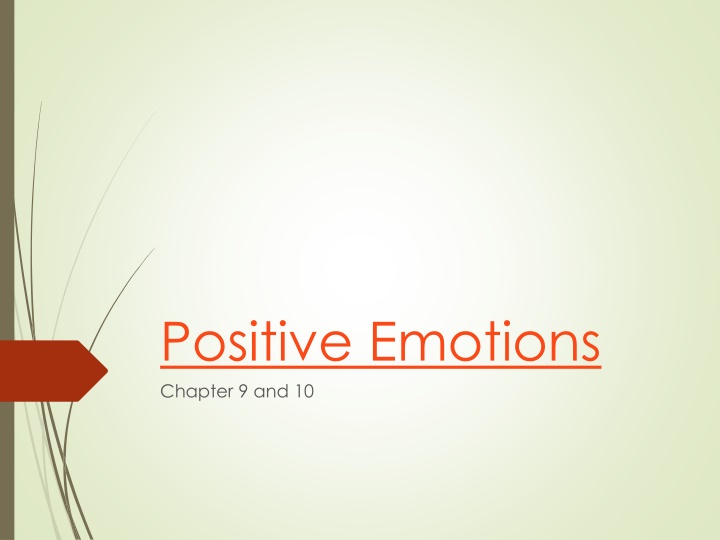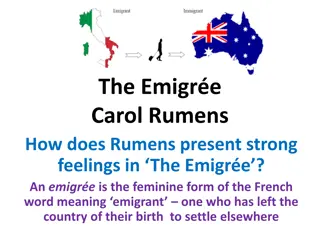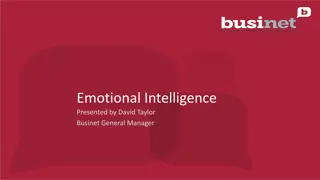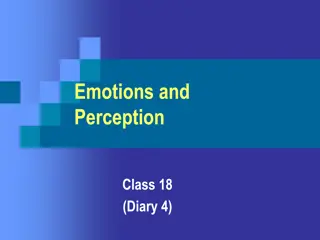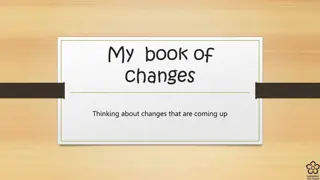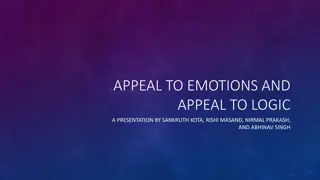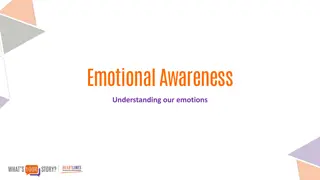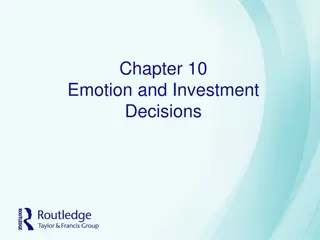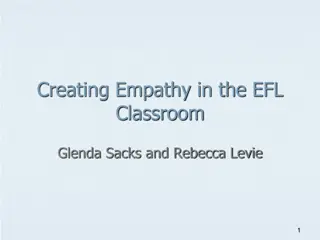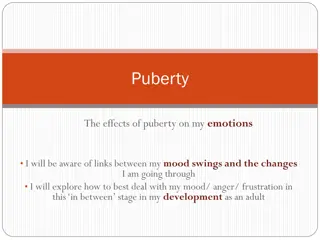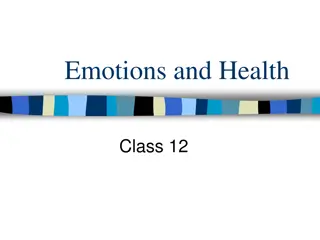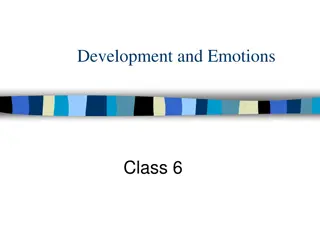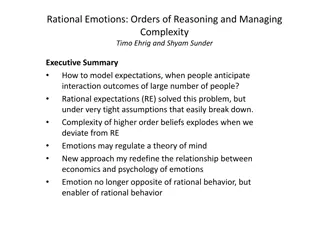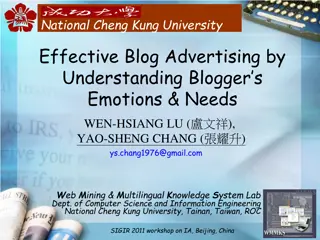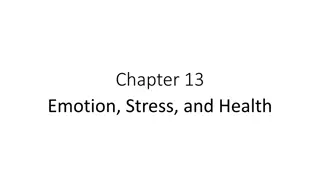Insights on Positive Emotions Research
Delve into the history and differentiation of positive emotions like joy, gratitude, and hope. Understand the distinct definitions and components of positive emotions, exploring their impact on psychological well-being and social connections.
Download Presentation

Please find below an Image/Link to download the presentation.
The content on the website is provided AS IS for your information and personal use only. It may not be sold, licensed, or shared on other websites without obtaining consent from the author.If you encounter any issues during the download, it is possible that the publisher has removed the file from their server.
You are allowed to download the files provided on this website for personal or commercial use, subject to the condition that they are used lawfully. All files are the property of their respective owners.
The content on the website is provided AS IS for your information and personal use only. It may not be sold, licensed, or shared on other websites without obtaining consent from the author.
E N D
Presentation Transcript
Positive Emotions Chapter 9 and 10
History of positive emotion research Emphasis has been on negative emotions Recall: Negative emotions are easier to understand Easier to differentiate negative emotions Easier to identify facial expression, physiology, etc. Positive emotions often co-occur
How many positive emotions? Barbara Fredrickson says 10! Joy, interest, contentment, gratitude, awe, amusement, inspiration, pride, hope, love Tong says 13! Joy, interest, contentment, gratitude, awe, amusement, pride, hope, love, challenge, compassion, interest, relief, serenity Not inspiration Ekman says 7! Happiness, amusement, excitement, wonder, ecstasy, Naches (Yiddsh vicarious pride), Fiero (Italian achieving difficult challenge) [Ekman, P., & Cordaro, D. (2011). What is meant by calling emotions basic. Emotion Review, 3, 364-370. doi: 10.1177/1754073911410740] [Tong, E.M.W. (2014). Differentiation of 13 positive emotions by appraisals. Cognition and Emotion, 29, 484-503. doi: 10.1080.02699931.2014.922056]
Distinct Positive Emotion Definition Good, unexpected fortune that occurs in safe and familiar environments. A feeling of wanting to investigate, become involved, or extend and expand the self by incorporating new information and new experiences Feeling of satisfaction or completion; savoring current life circumstances Positive feelings in response to a desired outcome caused by someone else. Joy Interest Contentment Gratitude Awe Feeling that something is greater or bigger than the self Amusement Benign events that violate expectations and cause humor. Inspiration Witnessing human excellence or a good deed. Taking credit for a positive outcome that supports favorable sense of self Pride Hope Anticipation that a positive outcome will result. Exploring and savoring experiences with other people; any positive emotion felt during an interpersonal connection. Love
Positive Emotions: 5 Components External Stimulus : physical stimulus not required Subjective feelings Pleasant Valence; High or Low Arousal Physiological changes SNS Activation, PNS Activation Behavior changes Facial expressions, approach/avoidance Cognitive appraisals Pleasantness, Novelty, Uncertainty, Personal Relevance, External or Internal Causation, High or Low Perceptions of Control, Goal Conduciveness (consistent with one s goals)
Cognitive Appraisals and Positive Emotions Singaporean and American undergraduates Recalled and described a personal experience of 1 randomly selected emotion Then, rated each emotion along 13 cog app of event causing the emotion Pleasantness, relevance, problems, goal attainment, agency-self, agency-others, agency- circumstances, control-self, control-others, control- circumstances, certainty, predictability, effort Located on last page of article [Tong, E.M.W. (2014). Differentiation of 13 positive emotions by appraisals. Cognition and Emotion, 29, 484-503. doi: 10.1080.02699931.2014.922056]
4 Broad Factors of Appraisals for Positive Emotions Achievement Appraisal Important goal was achieved by the self High = Pride, Challenge, Contentment, Joy Low = Compassion, awe, amusement External Influence Perception that events are caused by external forces High = Compassion, hope, gratitude; Low = Pride Difficulty Less pleasant, high effort, problematic experiences High = Challenge, compassion, hope, relief Low = Amusement, serenity, awe, contentment Clarity Sense of clarity or sureness about current and future circumstances High = contentment, pride, amusement, joy, serenity; Low = Hope [Tong, E.M.W. (2014). Differentiation of 13 positive emotions by appraisals. Cognition and Emotion, 29, 484-503. doi: 10.1080.02699931.2014.922056]
Awe and Two Cognitive Appraisals Awe positive and negative emotions Fear, surprise, interest, inspiration Vastness Anything perceived as larger than the self Physical size or social size (e.g., fame, prestige, authority) Need for Accommodation Process of adjusting mental structures to allow assimilation of awe-inspiring experience [Shiota, M.N., Keltner, D., & Mossman, A. (2007). The nature of awe: Elicitors, appraisals, and effects on self-concept. Cognition and Emotion, 21, 944-963 doi: 10.1080/02699930600923668]
Happiness: A positive emotion? In Ekman s primary emotions, happiness is one of the universal, basic emotions Happiness researchers (e.g., Fredrickson) claim that happiness is not a basic emotion, but a personality trait We will discuss happiness articles in the personality section Experiencing 10 positive basic emotions on frequent, daily basis is associated with happiness Joy, interest, contentment, gratitude, awe, amusement, inspiration, pride, hope, love
Influence and Outcomes of Positive Emotions Broaden and Build Theory Undoing Effect of Emotions Positive Emotion Interventions
Fredricksons Broaden and Build Theory Temporary and transient experiences of positive emotions Broaden Hypothesis: Change in behaviors, attention, and thinking due to positive emotions Build Hypothesis: lasting changes in personal resources that follow repeated positive emotional experiences over time.
Produces more experiences of positive emotions, creating an upward spiral. Enhanced health, survival, fulfillment Building enduring personal resources (e.g., social support, resilience, skills, and knowledge) Novel thoughts, activities, relationships Fredrickson s Broaden and Build Theory Positive Emotions
Produces more experiences of positive emotions, creating an upward spiral. Enhanced health, survival, fulfillment Builds long- lasting social bonds and attachments Laughter signals openness to new, friendly interactions (broadening) Fredrickson s Broaden and Build Theory Joy
Broaden Examples Building Examples Build and develop social bonds Attending to object Seeking information Reflecting on situation Integrating new information Savoring current circumstance Exploration Thanking someone Acting in prosocial ways Play Creativity Attachment and bonding Laughing Urge to reach personal best Perseverance Motivation for personal growth Optimism and resilience to adversity Achievement motivation Motor skill acquisition Reciprocity, altruism Encoding rewarding experiences Add new world views to self concept Knowledge Acquisition
More self-other overlap with best friend Positive Emotions Broaden Social Thoughts More imaginative and attentive about things to do for friends Increased trust and social bonds Positive Emotions Eliminate us vs. them mindset Improved memory for individuals from other races Less effective at perceiving physical differences between races
Inducing Positive Emotions and Building Builds intellectual resources - learning Builds reasoning skills Doctors and Diagnoses Increases altruism Participants who found coins (vs. not)
Undoing Effect of Negative Emotions When threat that caused negative emotion is no longer present Negative emotion may still linger Positive emotions may neutralize this lingering negative emotion
Undoing Effect of Negative Emotions Baseline Measures Induction: high-arousal, negative emotions in all Ps Film manipulation: Amusement: puppy playing with flower Contentment: waves breaking on the beach Neutrality: abstract movies of sticks piling up Sadness: a young boy crying DV: Cardiovascular Recovery
Cardiovascular Recovery Time = Start of Clip to Baseline Average Sadness Neutrality Content Amusement 0 10 20 30 40 50 Time (in seconds)
Clinical Applications Considering the undoing effect of positive emotions, how could you use any of the positive emotions as an intervention for depression? Joy Amusement Inspiration Pride Hope Love Interest Contentment Gratitude Awe
Positive Emotions Interventions Gratitude Journals Meditation Counting your blessings Helping another person Music Writing
Broaden-and-build Theory: Meditation Loving-Kindness Meditation Manipulation #1 Experimental Group trained in meditation Control: wait-listed for meditation workshop DV: daily number of discrete positive and negative emotions Personal resources (cognitive, psychological, social, physical) Baseline; 9-week study [Fredrickson, B.L., Cohn, M.A., Coffey, K.A., Pek, J., & Finkel, S.M. (2008). Open hearts build lives: Positive emotions, induced through loving-kindness meditation, build consequential personal resources. Journal of Personality and Social Psychology, 95, 1045-1062. doi: 10.1037/a0013262]
Broadens feelings of warmth and caring toward self and others Loving- Kindness Meditation Love, joy, gratitude, contentment, hope pride, interest, amusement, awe Positive Emotions Builds personal resources Life Satisfaction, Depression
Broaden-and-build Theory: Meditation Building Personal Resources Cognitive Mindfulness, agency and pathways thinking Agency: able to achieve goals Pathways: multiple ways to complete goals Psychological optimism, life purpose, self-acceptance Social social support given/received, greater relationship quality Physical reduced illness, increased sleep
Writing: Typical Procedures All participants write about assigned topics for 3-5 days, 15-30 min each day Experimental Group: write about an important emotional issues that has affected their life Control Group: write about superficial topics (use of time) DV = variety of measures Physical health Mental health [Pennebaker, J.W. (1997). Writing about emotional experiences as a therapeutic process. Psychological Science, 8, 162-166. doi:10.1111/j.1467-9280.1997.tb00403.x]
Writing: Typical Procedures Writing group (vs. control group): Better physical health fewer doctors visits, better immune system functioning Better psychological health better memory, more positive mood, higher well-being/happiness Strongest predictors of physical health Positive emotions words positively correlated with physical health Curvilinear relationship between negative emotion words and physical health [Pennebaker, J.W. (1997). Writing about emotional experiences as a therapeutic process. Psychological Science, 8, 162-166. doi:10.1111/j.1467-9280.1997.tb00403.x]
Summary: Positive Emotions The broaden- and build theory suggests positive emotions produce health and well- being. How much positivity is needed to flourish? Fredrickson and Losada say 3:1 But .. The broaden-and-build theory conveys how positive emotions move people forward and lift them to the higher ground of optimal well- being.
